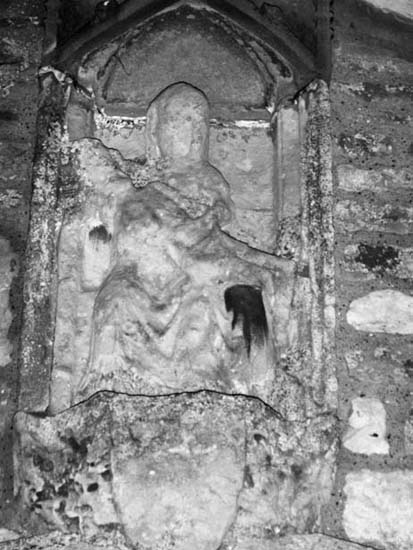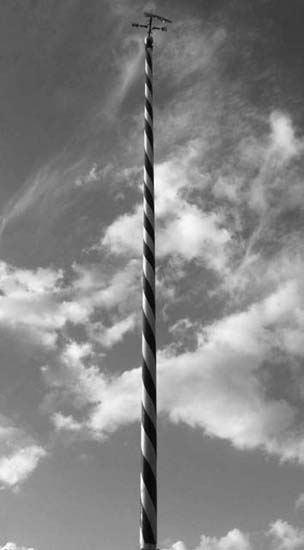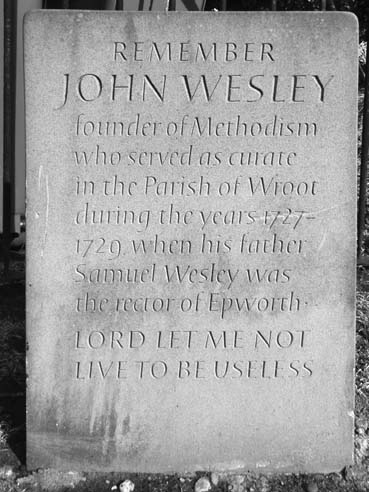Folklore of Lincolnshire (30 page)
Read Folklore of Lincolnshire Online
Authors: Susanna O'Neill

The gad-whip, preserved in a glass case on the wall of the church of St Peter and St Paul, Caister.

An effigy of Mary supporting the dead Jesus, over the porch entrance of St Peter’s Church, Glentham. The tradition of washing the image of Christ was once held here. This is thought to be the only remaining effigy of Mary holding Jesus’ body left in Lincolnshire and one of very few left in the country after the Reformation.
Even though it was taboo for women to do any washing or housework on Good Friday, it was apparently seen as a lucky day for farmers to plant their potatoes. Another Lincolnshire belief was that any person born on a Good Friday could not be frightened.
In the 1920s and ’30s, people believed that the sun danced on Easter morning and could forecast the weather for the rest of the year. A bucket of water was placed outside and as the sun rose it reflected upon the surface of it. It would ‘wap and wade’ which, when translated, meant that if it rippled it was meant to be a sign that there would be enough water all summer but if the sun moved slowly across the water it was expected to be a very dry summer.
Tansy pudding was a traditional dish for Easter Day, eaten with orange marmalade, supposed to represent the bitter herbs eaten with the paschal lamb.
Children were involved in egg-rolling competitions on Easter Monday, rolling hard-boiled eggs down hills to see which survived the longest. This was a symbol of the rolling away of the stone across Jesus’ tomb.
Hare Pie was a traditional dish for Easter Monday, constituting hare, hard-boiled eggs and a pastry case. There was a well-known practice at Hare Hill, near Louth, where such a pie made by the wife of the vicar was cut up and distributed to the gathered crowd.
Rudkin mentions a custom that was practiced every Easter in Bourne since 1770, the Meadow Letting custom.
10
A Mr Clay apparently gave a piece of land, White Bread Meadow, to the inhabitants on the condition that the rent was used for charitable purposes. Further conditions stipulated that two good loads of manure should be put on the land and that the bush in the middle of the field should not be cut or damaged, by man nor beast. Apparently, although the original is now gone, replacement bushes have always been planted. To decide who rented the land from year to year, a race was run by a number of boys. Once they were off the bidding began in the auction and as the race finished, the last person to bid had the lease for that year. After the bidding there was a feast of bread, cheese and spring onions. The race held today is more of a token of what was intended but the results of the auction are still legally binding.
Gutch and Peacock mention a game celebrated on the Tuesday a fortnight after Easter Sunday, called Holk.
11
Girls and boys would catch each other as they passed on the streets and refuse to let them go unless they paid a small fee. This money was then spent on a feast in the evening and great fun was said to be had by both parties, both day and evening.
Another moveable custom was to welcome the cuckoo, when it was first heard in the year, with a special cuckoo ale. It was also customary for girls to count the number of times it cuckooed, which signalled the number of years they would have to wait to be wed.
When April blows his horn ‘tis good for hay and corn.
April Fool’s Day was celebrated only half the day. People, children especially, would play tricks on each other all morning but if someone played a trick in the afternoon the common retort would be, ‘April Fool’s Day passed and gone and you’re the fool for making me one’. Widdowson
12
relates one particular trick a lady from Louth remembers from her childhood: ‘We always got a small piece of coal wrapped in a toffee paper in our lunch. Believe me, we should have been very disappointed if it had not been there!’
Known as Flitting Day, whereby all the farm workers and their families moved from their tied cottages to a new place of work. It was also the day they paid up the year’s rent. One theory for it occurring at this time of year is that it was near the equinox, the time many ancient cultures viewed as the start of the New Year. Flitting Day was an immense day for mothers, whose responsibility it was to get everything spick and span in the house for the newcomers. It was, however, seen as unlucky to move house on a Friday, so if the 6th fell on a Friday, people would wait another day to move.
An annual event held in Lincoln, this fair takes place on the South Common. It has been running for years and Sutton includes some memories from people who attended the fair in the early 1900s. There was dancing and stages with music, a variety of food on sale, coconut shies, shooting galleries, side shows such as a snake woman or the world’s fattest man, performing fleas, boxing matches, up and down horses, waltzers, swing yachts, cake walks, strong man acts, and more. The fair today is very similar apart from having a more modern, updated feel and faster rides!
Another event that was held for centuries, this was a huge affair, spreading out over all the streets, with hundreds of different horses stationed all across the town. It lasted a full week, at the end of April, and was massively popular but died out in the 1950s due to the increase in motorised vehicles and farming machinery. Enormous crowds would gather, with people travelling from all over the country
and so the inns and pubs all did a good trade that week as well as the ice-cream sellers and hot pea stalls. Even those not interested in buying a horse were attracted, and one girl Sutton mentions remembers her mother taking her along for the chance they might be given some free cabbages at the end of the day. Farmer’s apparently used to give away cabbages and other vegetables that the horses had not eaten, as it was easier than carting them all back home again.
St Mark’s Eve involved many different rituals connected with divining a future spouse. One such custom was for three girls to gather together and bake a dumb cake, in complete silence. The cake had to be prepared by midnight, for as the clock struck twelve each of the girls would tear themselves off a piece and eat it. Still silent, they would then walk backwards up the stairs to bed and if all was done correctly they were to see a shadow of their future husband following them up the stairs. One condition stated that they must get into bed before the shadow reached them.
For those who saw no shadow, a knocking sound may be heard on the door or a rustling in the house and this would reassure them they were still to find husbands – but the poor girl who was destined never to marry would neither see nor hear anything and may even have terrible dreams of death. As can be imagined, this practice lost popularity during the war years as so many young men were killed and thus the girls viewed it as a futile event.
Wash your face in the May morning dew, and you will have a fair face.
May Day is now the nearest Monday to the first of the month; it used to be the nearest Sunday. There are a host of traditional celebrations, including dancing around the maypole, processions, the crowning of the May Queen and prank playing.
‘Maying’ was a custom whereby the children of the village would visit all the houses with seasonal flowers and extract money and gifts from the residents. It was performed as a ritual to welcome in the May and the spring, and the garlands were made in a traditional oval shape, with dolls placed in the middle. The children were often given a few coppers, or if they were in short supply a pin to give their mothers. It was viewed as bad luck, however, to take the May blossom inside the house, which Sutton suggests could have been linked to the Catholic tradition of placing garlands in front of the statue of Mary. During the Reformation this was forbidden and could even result in death, and so people avoided the act.
May dancing was also a tradition. Morris men would welcome in the new month by dancing in the four corners of Lincoln; west, north, east and south. They had a
5 a.m. start on the 1 May and the bells they wore and sticks they knocked together were all tools with which to drive away the evil spirits from the city.

Maypole dancing was also a popular tradition during May and this is a fine example of a village maypole, seen in Hemswell, along Maypole Street.
Morris dancers also participate at the May Day Lincoln Folk Festival, which is a three-day event, first beginning in 1983. This event was linked to the Lincoln Arts Festival but soon became an occasion in its own right, involving many local and national folk musicians.
May is a month of flowers and there are many festivals celebrating the different flowers of the county, such as cowslips, lilies, tulips and blossom – all linked to this particular season and to the symbol of new life.
It was once custom to eat rook pie during this month on Rook Sunday, as the baby rooks venturing from their nests for the first time were easy pickings to catch. The pastry around the edge of the pie was marked using the feet of the rooks and some people would even serve their pie with the legs of the rook sticking up out of the middle.
Known as Pag Rag Day, this was the day that all the servants used to return home with all their dirty washing packed into white linen bags, known as pag bags.
This date was also known as Hiring Fair, as traditionally it was the day when farm workers were hired. The employers would know what jobs the men were looking for and which skills they possessed just by looking at what clothes they wore on this day and the tools they carried with them. When a deal was struck, the farmer would give the worker a shilling, known as a ‘fastening penny’, as a term of employment and then they would be paid a penny per month thereafter. Rudkin says that Brigg had the wonderful incentive of offering the first man to arrive in town, who was looking for work, a free pint.
13
As one can imagine, this became very competitive and men would be rolling up at five in the morning.
Lincolnshire is well known for the Wesley family, who resided at Epworth Rectory, the sons, John and Charles, well-known preachers in the 1730s. This date is known as Wesley Day, and they are remembered annually during the communion service in Lincoln Cathedral.

Remembrance stone for John Wesley, founder of Methodism, situated in Wroot, where he served as curate for two years.
‘Beating the Bounds’ was an old tradition used in many counties, Lincolnshire included, before accurate maps were produced. Where there might be disputes over
the boundaries people would go out and beat down growth and mark the soil to show the younger generations where the boundaries were. Bourne Abbey Church is one of the few places left that still marks the tradition by taking people from the parish out, in May, and walking the boundary paths.
Boston May Fair was a large horse, cattle and sheep market but was also known as something of a pleasure fair, where even quack doctors would attend, selling their herbal medicines and remedies. It is still a popular event today, though more of a pleasure fair than anything.
